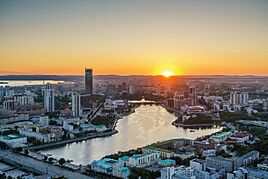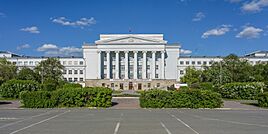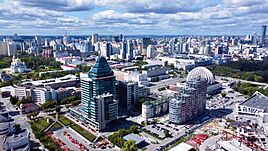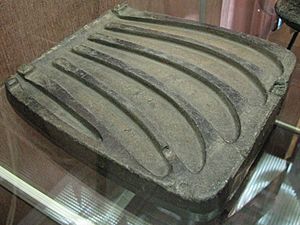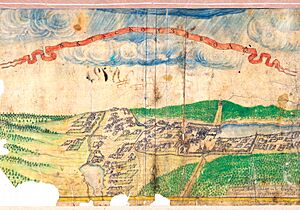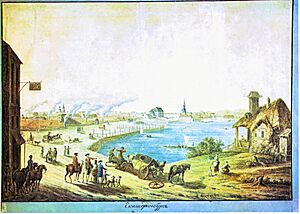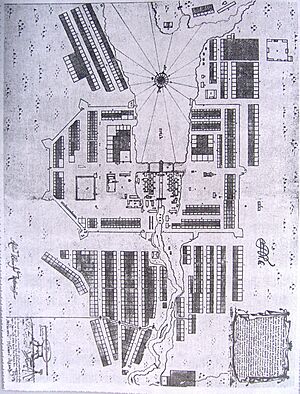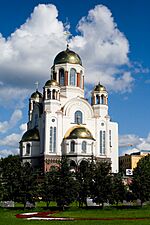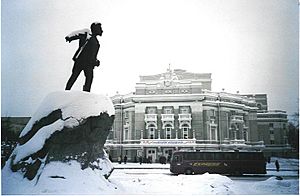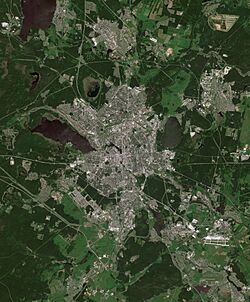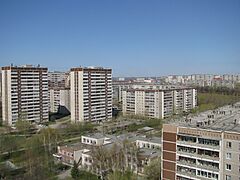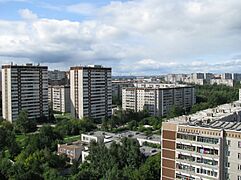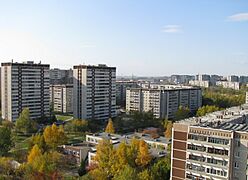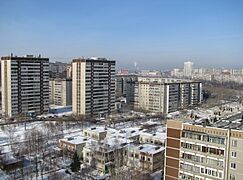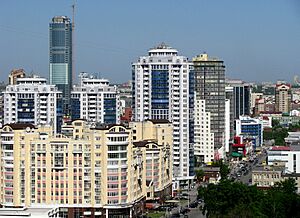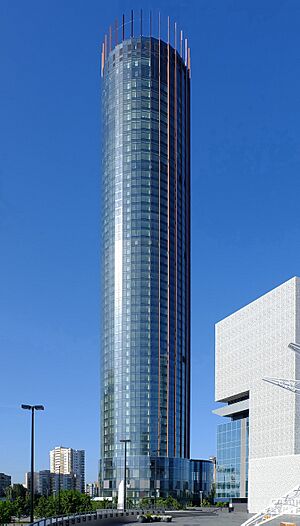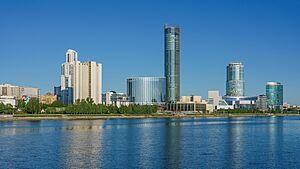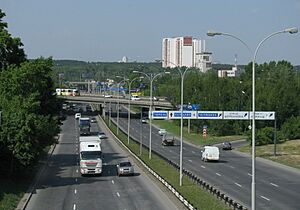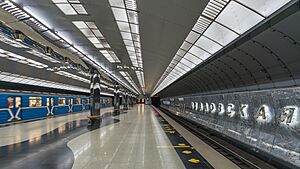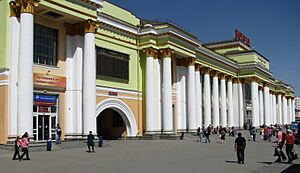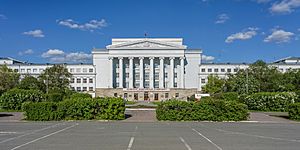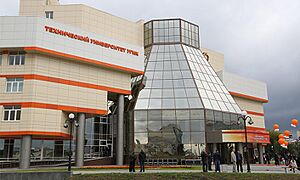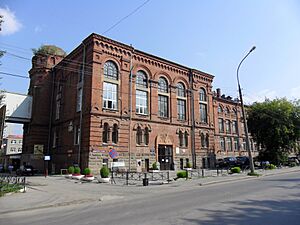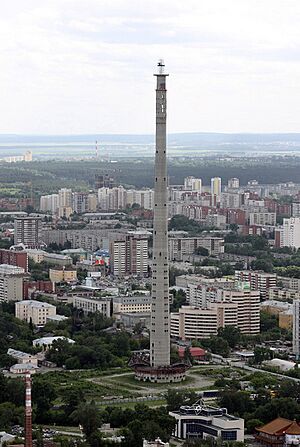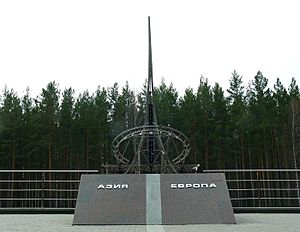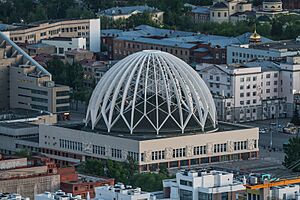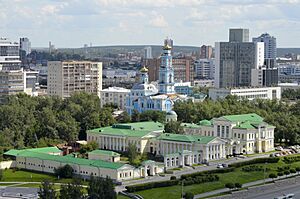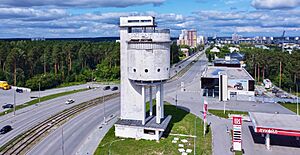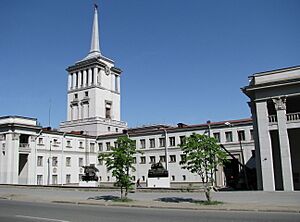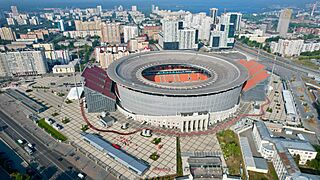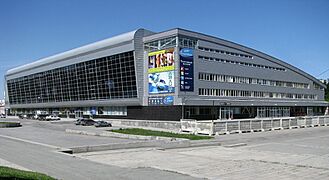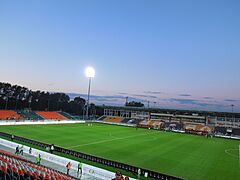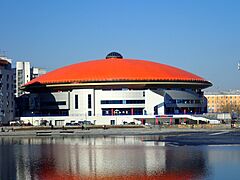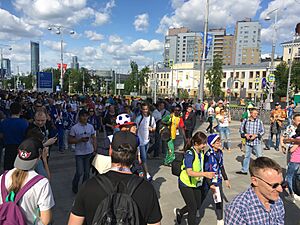Yekaterinburg facts for kids
Quick facts for kids Yekaterinburg (English)Екатеринбург (Russian) |
|
|---|---|
| - City - | |
| [[File:
View of Yekaterinburg-City and the Iset River from Vysotsky Skyscraper
Church of All Saints
Sevastyanov's house
Main building of Ural Federal University
Summit Business Center and Yekaterinburg Circus
|
|
|
|
|
| City Day | 3rd Saturday of August |
| Administrative status | |
| Country | Russia |
| Federal subject | Sverdlovsk Oblast |
| Administratively subordinated to | City of Yekaterinburg |
| Municipal status | |
| Urban okrug | Yekaterinburg Urban Okrug |
| Head | Alexey Orlov |
| Representative body | City Duma |
| Statistics | |
| Area | 1,111 km2 (429 sq mi) |
| Population (2010 Census, preliminary) |
1,349,772 inhabitants |
| - Rank in 2010 | 4th |
| Population (2024 est.) | 1,536,183 inhabitants |
| Density | 1,215/km2 (3,147/sq mi) |
| Time zone | YEKT (UTC+06:00) |
| Founded | 18 November 1723 |
| City status since | 1781 |
| Postal code(s) | 620000 |
| Dialing code(s) | +7 343 |
| Official website: https://екатеринбург.рф/ | |
Yekaterinburg is a large city in Russia. It is the main city of Sverdlovsk Oblast and the Ural Federal District. The city is located on the Iset River, between the Volga-Ural region and Siberia. About 1.5 million people live here, making it the fourth-largest city in Russia. It is also the biggest city in the Ural Federal District. Yekaterinburg is known as an important cultural and industrial center. Some even call it the "Third capital of Russia" because of its strong economy, culture, transportation, and tourism.
Yekaterinburg was founded on November 18, 1723. It was named after Catherine I, the wife of Russian Emperor Peter the Great. The city became a major mining center for the Russian Empire. It was also a key link between Europe and Asia. In 1781, Catherine the Great made Yekaterinburg a district town of Perm Province. She also built the historic Siberian Route through the city. This made Yekaterinburg a vital city for Siberia, which had many rich resources.
In the late 1800s, Yekaterinburg became a center for revolutionary movements in the Urals. In 1924, after the Russian SFSR formed the Soviet Union, the city was renamed Sverdlovsk. This new name honored the Bolshevik leader Yakov Sverdlov. During the Soviet era, Sverdlovsk grew into a powerful industrial and administrative hub. On September 23, 1991, the city returned to its original name, Yekaterinburg.
Today, Yekaterinburg is one of Russia's most important economic centers. It was also one of the cities that hosted the 2018 FIFA World Cup. The city has been growing rapidly in economy and population. This growth has led to some of the tallest skyscrapers in Russia being built there. Yekaterinburg is home to the main offices of the Central Military District of the Russian Armed Forces. It also hosts the Ural Branch of the Russian Academy of Sciences.
Yekaterinburg is famous for its constructivist architecture. It is also known as the "Russian capital of street art".
Contents
History of Yekaterinburg
Early Settlements
People lived in this area long before the city was founded. The oldest settlements date back to 8000–7000 BC, during the Middle Stone Age. An archaeological site called Isetskoe Pravoberezhnoye I shows a Neolithic (New Stone Age) settlement from 6000–5000 BC. This site has workshops where stone tools were made. Over 50 types of rocks and minerals were used, showing that people knew a lot about the region's natural resources.
The Gamayun peninsula also has findings from the Copper Age. These include workshops for stone tools and homes from the Ayat culture. There are also signs of the Koptyak culture from 2000 BC. This includes pottery with bird designs and proof of metal production. The Tent I site has the only Koptyak culture burials found in the Ural Mountains. During the Bronze Age, people of the Gamayun culture lived here. They left behind pieces of pottery, weapons, and ornaments.
Archaeological items near Yekaterinburg were first found when railways were being built in the late 1800s. Digging and research started in the 1900s. These artifacts are now kept in museums like the Sverdlovsk Regional Museum of Local Lore and the Hermitage Museum.
Founding the City
The first Russian villages in the Yekaterinburg area appeared in the late 1600s. In 1702, the Uktus state ironwork plant was built. This was the first ironworks in what is now Yekaterinburg. However, this plant faced problems like fires and not enough water.
In 1720, Peter I sent experts, including Vasily Tatishchev and Georg Wilhelm de Gennin, to the Urals. Their job was to improve the mining industry. Tatishchev realized that building a new, larger plant would be better than fixing the old ones. He chose a spot on the Iset River, which had plenty of ore and forests.
Construction of the new plant began on March 1, 1721. However, Tatishchev was removed from his role. In 1722, Peter the Great sent Georg Wilhelm de Gennin to take over. De Gennin supported Tatishchev's plan. On March 12, 1723, construction of the plant on the Iset River started again.
Yekaterinburg was officially founded on November 18, 1723. This was when the new iron-making plant had its first test run. The city was named after Emperor Peter the Great's wife, Yekaterina, who later became Empress Catherine I. A fortress was also built in 1723 to protect the new settlement.
The city grew with more plants and settlements nearby. The Verkh-Isetsky plant was built in 1726. It became a satellite town and was later included into Yekaterinburg in 1926.
Growth and Importance
Yekaterinburg became an important industrial city in Russia. It was built with a clear plan, having ironworks and homes in the center. Fortified walls surrounded these buildings. This made Yekaterinburg both a manufacturing hub and a fortress. It was a key part of Russia's plan to develop the Ural region.
The Siberian Route opened in 1763. This road made Yekaterinburg an important trade route between Europe and Asia. It was even called the "window to Asia." As trade and administration grew, the ironworks became less central. More important buildings were built with expensive stone. Small businesses for manufacturing and trade also grew.
In 1781, Empress Catherine the Great made Yekaterinburg a town. She also made it the administrative center for the wider region. In 1807, it was confirmed as the capital of the mining and smelting region. It was the only "mountain city" in Russia. From the 1830s, Yekaterinburg became a center for mechanical engineering.
Between 1820 and 1845, Yekaterinburg produced 45% of the world's gold. This was the first "Gold Rush." Until 1876, 80% of the coins used in the Russian Empire were made at the Yekaterinburg mint.
After the October Revolution, the family of the last Tsar, Tsar Nicholas II, was sent to Yekaterinburg. They were held in the Ipatiev House. In July 1918, the Czechoslovak Legions were getting close to the city. In the early morning of July 17, the Tsar, his wife Alexandra, and their children died in the Ipatiev House. Other members of the Romanov family also died in Alapayevsk later that day. The Legions captured the city less than a week later. The city was under the control of the White movement for a while. The Red Army took back the city on July 14, 1919.
Soviet Era Changes
After the Russian Revolution and the Russian Civil War, Yekaterinburg became the main political center of the Urals. On October 19, 1920, Yekaterinburg opened its first university, the Ural State University. Other schools for technology, teaching, and medicine also started. Factories damaged by the war were taken over by the government. In 1924, Yekaterinburg was renamed Sverdlovsk, after the Bolshevik leader Yakov Sverdlov.
By 1934, many older Russian settlements were made part of the city. During the time of Stalin, Sverdlovsk became a major center for heavy industry. Old factories were rebuilt, and new, large factories were constructed. These new plants focused on making machines and working with metal. The population of Sverdlovsk tripled, making it one of the fastest-growing cities in the Soviet Union. By the late 1930s, Sverdlovsk had 140 industrial businesses, 25 research centers, and 12 universities.
During World War II, the city became the main office for the Ural Military District. Over 500 military units were formed here. Uralmash became a key place for making armored vehicles. Many government technical schools and entire factories moved to Sverdlovsk from war-affected cities like Moscow. Many of them stayed after the war. Collections from the Hermitage Museum were also moved to Sverdlovsk from Leningrad in July 1941 and stayed until October 1945.
After the war, new factories and farms started working. Many new homes were built. The five-story apartment buildings seen today in areas like Kirovsky and Chkalovsky were built in the 1960s. In 1977, the Ipatiev House was taken down to prevent it from becoming a gathering place for people who supported the monarchy. Boris Yeltsin, who later became the first President of Russia, ordered its demolition.
Modern Yekaterinburg
During the 1991 coup attempt, Sverdlovsk was chosen by President Boris Yeltsin as a temporary capital for Russia. This was in case Moscow became too dangerous. After the coup failed and the Soviet Union broke apart, the city got its historical name, Yekaterinburg, back on September 23, 1991. However, Sverdlovsk Oblast, the region it is in, kept its name.
In the 2000s, Yekaterinburg saw a lot of growth in trade, business, and tourism. In 2003, Russian President Vladimir Putin and German Chancellor Gerhard Schröder met in Yekaterinburg. In June 2009, the SCO and BRIC summits were held here. These events greatly helped the city's economy, culture, and tourism. In July 2010, Russian President Dmitry Medvedev and German Chancellor Angela Merkel also met in the city.
In 2018, Yekaterinburg hosted four matches of the 2018 FIFA World Cup. In 2023, it hosted the first University International Sports Festival.
Geography
Location and Landscape
Yekaterinburg is located in North Asia, very close to the Ural Mountains. These mountains act as a natural border between Europe and Asia. The city is about 1667 kilometers (1036 miles) east of Russia's capital, Moscow.
The city covers a total area of 1111 square kilometers (429 square miles).
Yekaterinburg is on the eastern side of the Urals. It is surrounded by wooded hills, some of which are used for farming. The city is on a natural watershed, meaning there are many bodies of water nearby and within the city. The Iset River flows through the city, coming from the Urals and going into the Tobol River. There are two lakes in the city: Lake Shuvakish and Lake Shartash. The city also borders Verkh-Isetskiy Pond, which the Iset River flows through. Lake Isetskoye and Lake Baltym are also close to the city.
Time Zone
Yekaterinburg uses Yekaterinburg Time. This time zone is five hours ahead of UTC (UTC+5). It is also two hours ahead of Moscow Time.
Climate and Weather
Yekaterinburg has a humid continental climate. This means it has distinct seasons and the weather can change quickly. The Ural Mountains block air from the west, but the city is open to cold air from the Arctic and continental air from Siberia. Warm air from the Caspian Sea and Central Asian deserts can also reach the city. Because of this, Yekaterinburg often has big temperature changes. In winter, it can go from very cold (-40 °C) to mild and rainy. In summer, it can go from cold to very hot (over 35 °C).
Most of the rain and snow comes from western air masses. The city gets about 601 millimeters (23.7 inches) of precipitation each year. Most of this falls during the warmer months. In winter, there is usually a snow cover about 40–50 centimeters (16–20 inches) deep.
- The average temperature in January is -12.6 °C (9.3 °F). The coldest ever recorded was -44.6 °C (-48.3 °F) in 1915.
- The average July temperature is 18.9 °C (66.0 °F). The hottest ever recorded was 40.0 °C (104.0 °F) in 2023.
- The average yearly temperature is 2.1 °C (35.8 °F).
- The average yearly wind speed is 2.9 meters per second (6.5 mph).
- The average yearly humidity is 75%.
- The average yearly precipitation is 534 millimeters (21.0 inches).
| Climate data for Yekaterinburg (1991–2020, extremes 1831–present) | |||||||||||||
|---|---|---|---|---|---|---|---|---|---|---|---|---|---|
| Month | Jan | Feb | Mar | Apr | May | Jun | Jul | Aug | Sep | Oct | Nov | Dec | Year |
| Record high °C (°F) | 5.6 (42.1) |
9.4 (48.9) |
18.1 (64.6) |
28.8 (83.8) |
34.7 (94.5) |
36.4 (97.5) |
40.0 (104.0) |
37.2 (99.0) |
31.9 (89.4) |
24.7 (76.5) |
13.5 (56.3) |
5.9 (42.6) |
40.0 (104.0) |
| Mean daily maximum °C (°F) | −9.3 (15.3) |
−6.6 (20.1) |
0.9 (33.6) |
10.1 (50.2) |
18.3 (64.9) |
22.6 (72.7) |
24.3 (75.7) |
21.4 (70.5) |
15.0 (59.0) |
6.9 (44.4) |
−2.6 (27.3) |
−7.8 (18.0) |
7.8 (46.0) |
| Daily mean °C (°F) | −12.6 (9.3) |
−10.8 (12.6) |
−3.6 (25.5) |
4.7 (40.5) |
12.2 (54.0) |
16.9 (62.4) |
18.9 (66.0) |
16.2 (61.2) |
10.4 (50.7) |
3.6 (38.5) |
−5.4 (22.3) |
−10.7 (12.7) |
3.3 (37.9) |
| Mean daily minimum °C (°F) | −15.5 (4.1) |
−14.1 (6.6) |
−7.3 (18.9) |
0.3 (32.5) |
6.9 (44.4) |
12.0 (53.6) |
14.4 (57.9) |
12.2 (54.0) |
6.8 (44.2) |
1.0 (33.8) |
−7.8 (18.0) |
−13.3 (8.1) |
−0.4 (31.3) |
| Record low °C (°F) | −44.6 (−48.3) |
−42.4 (−44.3) |
−39.2 (−38.6) |
−21.8 (−7.2) |
−13.5 (7.7) |
−5.3 (22.5) |
1.5 (34.7) |
−2.2 (28.0) |
−9.0 (15.8) |
−22.0 (−7.6) |
−39.2 (−38.6) |
−44.0 (−47.2) |
−44.6 (−48.3) |
| Average precipitation mm (inches) | 25 (1.0) |
19 (0.7) |
25 (1.0) |
31 (1.2) |
47 (1.9) |
73 (2.9) |
93 (3.7) |
75 (3.0) |
45 (1.8) |
41 (1.6) |
33 (1.3) |
28 (1.1) |
534 (21.0) |
| Average extreme snow depth cm (inches) | 33 (13) |
42 (17) |
38 (15) |
5 (2.0) |
0 (0) |
0 (0) |
0 (0) |
0 (0) |
0 (0) |
1 (0.4) |
8 (3.1) |
21 (8.3) |
42 (17) |
| Average rainy days | 1 | 1 | 5 | 13 | 20 | 20 | 19 | 22 | 22 | 17 | 6 | 1 | 147 |
| Average snowy days | 26 | 23 | 18 | 10 | 4 | 0.4 | 0 | 0 | 2 | 13 | 23 | 25 | 144 |
| Average relative humidity (%) | 79 | 75 | 68 | 60 | 58 | 63 | 68 | 73 | 75 | 75 | 78 | 79 | 71 |
| Mean monthly sunshine hours | 47 | 94 | 164 | 206 | 256 | 272 | 269 | 217 | 143 | 78 | 51 | 37 | 1,834 |
| Source 1: Pogoda.ru | |||||||||||||
| Source 2: NOAA (sun 1961–1990) | |||||||||||||
People and Culture
Population and Diversity
| Historical population | ||
|---|---|---|
| Year | Pop. | ±% |
| 1897 | 37,399 | — |
| 1926 | 134,831 | +260.5% |
| 1939 | 425,533 | +215.6% |
| 1959 | 778,602 | +83.0% |
| 1970 | 1,025,045 | +31.7% |
| 1979 | 1,211,172 | +18.2% |
| 1989 | 1,364,621 | +12.7% |
| 2002 | 1,293,537 | −5.2% |
| 2010 | 1,349,772 | +4.3% |
| 2021 | 1,544,376 | +14.4% |
In 2021, the population of Yekaterinburg was 1,544,376 people. This was an increase from 1,349,772 people in 2010.
Most people in Yekaterinburg are Russians. Other groups include Tatars, Tajiks, Kyrgyz, and Bashkirs. This mix of people makes the city diverse.
Religion in Yekaterinburg
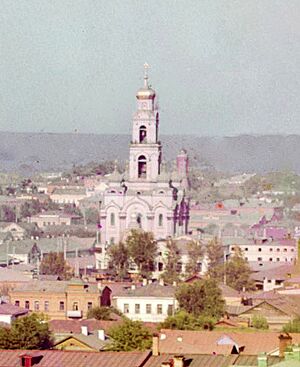
Christianity is the main religion in Yekaterinburg. Most Christians belong to the Russian Orthodox Church. The main Orthodox church in the city is the Holy Trinity Cathedral. Other religions practiced here include Islam, Old Believers, Catholicism, Protestantism, and Judaism.
Yekaterinburg has a notable Muslim community. There are two small mosques in the city. A larger mosque was planned but its construction is currently on hold. A synagogue was opened in 2005, replacing one that was taken down in 1962.
Many religious buildings were destroyed during the Soviet era. This included three large Orthodox churches and other Christian churches. Some churches were used as warehouses. The only religious building that remained open in the Soviet era was the Cathedral of St. John the Baptist. Recently, some churches have been rebuilt. The Great Zlatoust Church was restored in 2012.
City Government
Yekaterinburg is the administrative centre of Sverdlovsk Oblast. It is considered a "City of Yekaterinburg" within the region. This means it has a special status, similar to a district. As a municipal division, it is called the Yekaterinburg Urban Okrug.
The city's government has four main parts:
- The Head of Yekaterinburg, who leads the City Duma.
- The Yekaterinburg City Duma, which represents the city's people.
- The Administration of the City of Yekaterinburg, which manages the city.
- The Chamber of Accounts, which checks the city's finances.
The mayor of Yekaterinburg is the highest official. The mayor used to be chosen by public vote. However, since April 3, 2018, the mayor is no longer directly elected by citizens. The mayor leads the City Duma and makes sure city rules follow Russian laws.
The Yekaterinburg City Duma has 36 members. These members are chosen by the city's residents every 5 years.
The Administration of the City of Yekaterinburg handles the city's daily operations. It is led by the head of the Administration. The main building for the Administration is on 1905 Square.
The Chamber of Accounts checks how the city's money is spent. It works with the City Duma.
Regional and Federal Roles
Yekaterinburg is the administrative center of the Sverdlovsk Oblast. The governor leads the region's executive power. The legislative assembly handles laws. The Sverdlovsk Regional Court manages judicial power. The regional government building is called the White House.
Yekaterinburg is also the center of the Ural Federal District. This means it is home to the Presidential Envoy, a high-ranking official who represents the President of Russia. The envoy's office is near the Iset River.
Additionally, Yekaterinburg is the center of the Central Military District. It also has over 30 federal offices that serve not only Sverdlovsk Oblast but also other regions in the Urals, Siberia, and the Volga Region.
Economy and Business
Economic Overview
Yekaterinburg is one of Russia's biggest economic centers. It is on the "City-600" list, which includes the 600 largest cities in the world. These cities produce 60% of the world's total economic output. In 2010, experts estimated Yekaterinburg's economy to be about $19 billion.
Yekaterinburg ranks third in Russia for its economy, after Moscow and St. Petersburg. In 2015, the city's total economic output was 898 billion rubles. This put it in third place among large Russian cities.
In the Soviet era, Yekaterinburg (then Sverdlovsk) was mainly an industrial city. About 90% of its economy came from industry, with a large part being defense production. Along with Chelyabinsk and Perm, it formed a major industrial area in the Urals.
The city's former head, Arkady Chernetsky, wanted to make the economy more diverse. Now, Yekaterinburg has grown in areas like warehousing, transportation, logistics, and finance. It also has strong wholesale and retail trade. Today, Yekaterinburg is less focused on just industry.
Living and Working
The quality of life in Yekaterinburg is higher than the average across Russia. It is among the top ten cities with the best living standards. Compared to other large Russian cities, Yekaterinburg had high average monthly wages and retail sales in 2015. It also ranked high in investments and new housing.
In 2019, the average monthly wage in Yekaterinburg was 54,976 rubles. This was the highest among Russian cities with over a million people. About 440,300 people work for large and medium-sized companies. The unemployment rate in late 2015 was very low, at 0.83%.
The city's budget in 2015 was 32.06 billion rubles in income and 32.74 billion rubles in expenses. A large part of the money (17 billion rubles) was spent on education. Over 1 billion rubles went to culture, and about 900 million rubles to health. Most of the city's income came from its own taxes and other earnings.
Finance and Business
Yekaterinburg is a major financial and business center in Russia. It has offices for international companies and many Russian and foreign banks. The city's financial market is strong and stable.
More than 100 banks operate in Yekaterinburg, including 11 foreign banks. Several large Russian banks are based here, such as Ural Bank for Reconstruction and Development and SKB-Bank.
The Ural headquarters of the Central Bank of Russia is also in Yekaterinburg. Since August 7, 2017, it has managed bank branches in several federal districts. This makes it one of the three main offices for banking regulation in Russia.
Yekaterinburg's good transportation and services help it be a business hub. It has many hotels, advanced communication services, and business support services. The city even has its own central business district, called Yekaterinburg City.
Industry and Production
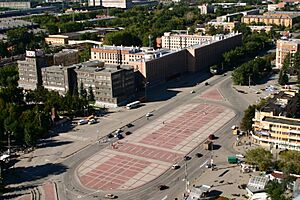
Yekaterinburg has been an important industrial center since it was founded. In the 1700s, it focused on metal smelting and processing. In the 1800s, machine building started. Later, light industry and food production, especially milling, became common.
During the Soviet era, new large factories were built, especially for heavy engineering. During World War II, about sixty factories moved to Yekaterinburg from other parts of Russia and Ukraine. This greatly increased the city's production power.
Today, Yekaterinburg has over 220 large and medium-sized businesses. In 2015, they produced 323.28 billion rubles worth of goods. The main industries are metal production, food production, electrical equipment, and vehicle manufacturing.
Many large Russian industrial companies have their main offices in Yekaterinburg. These include Uralmash (Ural Heavy Machinery Plant), Russian Copper Company, and Sinara Group.
Shopping and Services
Yekaterinburg leads Russia in retail trade per person, even ahead of Moscow. The consumer market is a big part of the city's economy. In 2015, retail stores made 725.9 billion rubles in sales. There were 4,290 retail businesses.
As of 2016, the city had 36 shopping centers. This means there was a lot of shopping space for every person. Yekaterinburg has many national and international retail chains. There are also 1,435 wholesale businesses.
The food service industry made 38.6 billion rubles in 2015. Yekaterinburg has many restaurants, bars, cafes, and fast-food places. Most of these businesses offer extra services to customers.
The services industry made 74.9 billion rubles in 2015. Hairdressing, sewing, pawn shops, and fitness centers are growing fast. There are over 5,000 service businesses in the city.
Greenwich Shopping Center is one of the largest shopping centers in Europe. Sima-Land is known as the largest store in the world by area.
Tourism in Yekaterinburg
Yekaterinburg is a major center for tourism in Russia. In 2015, it was one of the top five most visited Russian cities. The city has worked hard to attract international tourists. It hosted the Shanghai Cooperation Organisation (SCO) summits in 2008 and 2009. It also hosted the international exhibition Innoprom in 2009 and 2010. In 2014, Yekaterinburg was the third most popular Russian city for foreign tourists, after Moscow and St. Petersburg.
In 2015, the number of tourists grew by 10% to 2.1 million people. While business trips used to be the main reason for visits, now more people come for other reasons. Many tourists visit to remember the last royal family. New tourism ideas are also growing, like exploring the Bazhov theme (related to local folklore), geology, industrial tourism, and special events.
Transportation
Yekaterinburg is the third largest transport hub in Russia, after Moscow and St. Petersburg. The city has 6 federal highways, 7 main railway lines, and an international airport. Its central location in the region means you can reach any major city in the Urals within 7 to 10 hours. Yekaterinburg became an important transport hub because it is located on a low part of the Ural Mountains. This made it easy to build main roads connecting the European and Eastern parts of Russia.
Roads and Highways
Yekaterinburg is one of the ten Russian cities with the most cars. The number of cars has been growing fast, by 6–14% each year. In 2015, there were 410 cars for every 1,000 people. This growth has been faster than the development of roads. Traffic problems started in the 1980s and have gotten worse, leading to constant traffic jams.
To help with traffic, the city is rebuilding streets and building multi-level road junctions. In 2014, two major road projects were announced: the Yekaterinburg Ring Road (EKAD) and an overpass on Sovetskaya Street. The Ring Road will go around the city's largest areas. It aims to boost the economy and reduce traffic in the city center. This will make it easier for people to travel around the city. The Ring Road will also connect to other federal roads, making travel between Russian cities easier. Construction of the road began in 2014. These projects are important for the city's economy. Officials hope they will improve life for residents and attract more investments.
Since 2014, paid parking has been introduced in the central part of Yekaterinburg. This project also includes building more parking lots. By the end of 2015, there were 2,307 paid parking spaces in the city center.
The total length of roads in Yekaterinburg is 1311.5 kilometers (815 miles). This includes 929.8 kilometers (578 miles) of paved roads. There are 20 road junctions at different levels, including 11 on the EKAD. The city also has 74 transport structures, like bridges and overpasses.
Yekaterinburg is served by these highways:
Public Transportation
Yekaterinburg uses almost all types of public transport. In 2015, buses, trams, trolleybuses, and the metro carried 207.4 million people. However, the total number of passengers using land transport has been decreasing each year.
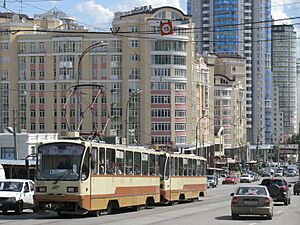
The Yekaterinburg Metro opened in 1991. It is the sixth metro system in Russia. It currently has one line with 9 stations. In 2015, 49.9 million passengers used the metro. It is the fourth busiest metro in Russia. Even though it's popular, the metro faces challenges like being expensive to run and having old trains.
The tram network started in 1929 and is very important for city transport. In 2013, 127.8 million people used trams. In 2016, there were 30 tram routes with 459 cars. The total length of tram tracks is 185.5 kilometers (115.3 miles). A new tram line to Verkhnyaya Pyshma was planned in 2016.
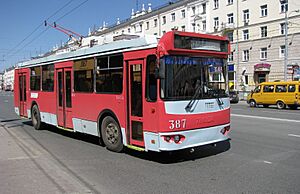
Yekaterinburg has 93 bus routes. In 2007, municipal buses carried 114.5 million passengers. The number of bus passengers has decreased because more people use smaller, private taxis. However, city buses provide many jobs. In 2013, there were 19 trolleybus routes with 250 trolleybuses. The total length of trolleybus lines is 168.4 kilometers (104.6 miles).
The city also has an electric train route. It connects the northwestern and southern parts of Yekaterinburg.
Rail Transport
Yekaterinburg is a major railway hub. Seven main railway lines meet here, connecting to cities like Perm, Tyumen, and Chelyabinsk. The Sverdlovsk Railway Administration is located in the city. It manages trains in several regions. The Perm–Yekaterinburg–Tyumen section is part of the famous Trans-Siberian Railway.
Air Travel
Yekaterinburg has two main airports: Koltsovo International Airport (SVX) and the smaller Yekaterinburg Aramil Airport. Koltsovo Airport is one of Russia's largest airports. In 2017, it served 5.404 million passengers, making it the sixth busiest airport in Russia.
For the 2018 FIFA World Cup, Koltsovo Airport was upgraded. A second runway was built, and a new passenger terminal was prepared. The airport's capacity increased to two thousand people per hour.
Health and Education
Healthcare Services
Yekaterinburg has many hospitals and clinics. There are 54 hospitals with 18,200 beds, 272 outpatient clinics, and 156 dental clinics. Some healthcare facilities are part of medical research institutes, like the Research Institute of Phthisiopulmonology.
In cleaner areas of the city, there is the Yekaterinburg Medical Centre. This includes the Sverdlovsk Regional Clinical Hospital No. 1 and Central City Hospital No. 40. Other large medical centers include the Uralmash Health Centre and the Regional Cardiology Centre.
The city has about 300 pharmacies. There are 11,339 doctors and 16,795 nurses working in public medical institutions. Private medical facilities also operate in the city.
Education System
Yekaterinburg's education system includes schools for all ages. It is one of Russia's largest educational centers. Yekaterinburg is seen as the leading educational and scientific hub in the Urals.
There are 164 educational institutions in Yekaterinburg. In 2015, 133,800 students were in general education schools. The city's education system also includes preschools and health camps. Several schools in Yekaterinburg are ranked among the best in Russia.
The Ural Mining Institute of Emperor Nicholas II was established in 1914. It was Yekaterinburg's first higher education institution. The Ural State University became the city's first university in 1920.
Yekaterinburg's universities are known for their high-quality graduates. Many graduates become leaders in the country. The city has 20 state universities with a total of 140,000 students. There are also 14 private higher education institutions.
In May 2011, the Ural State University and Ural State Technical University merged. They formed the Boris N. Yeltsin Ural Federal University. This made it the largest university in the Urals and one of the largest in Russia. As of 2016, the university had 35,300 students and 2,950 teachers. In 2021, UrFU was the largest university in Russia by student numbers.
Many branches of universities from other cities are also in Yekaterinburg.
Media and Communication
Yekaterinburg has many newspapers and magazines. Some popular newspapers include Ural Worker and Vecherny Yekaterinburg. Popular magazines include Red Burda.
A television studio was built in Yekaterinburg (then Sverdlovsk) in 1955. The first TV broadcast was on November 6, 1955. Color television started in 1976. Now, 19 companies broadcast television in the city. Broadcasting happens from several TV towers.
In 1981, construction began on a new television tower. It was meant to be the second tallest in Russia. However, it was never finished due to economic problems. On March 24, 2018, the unfinished television tower was taken down to improve the city's appearance for the 2018 FIFA World Cup. The Shartash radio mast is now the tallest structure in the city, at 263 meters (863 feet). Many national and local news agencies also broadcast in Yekaterinburg.
Currently, there are 26 internet providers and 6 mobile phone companies in the city. Yekaterinburg has partnered with the mobile operator Vimpelcom (Beeline brand). This partnership aims to improve mobile services in the city. Beeline has also started providing Wi-Fi on 500 public trams and trolleybuses in Yekaterinburg.
| Generation | Mobile communication standard | Operators |
|---|---|---|
| 2G | GSM | MTS, MegaFon, Beeline, Tele2 Russia, Motive |
| 2.5G | GPRS | MTS, MegaFon, Beeline, Tele2 Russia, Motive |
| 2.75G | EDGE | MTS, MegaFon, Beeline, Tele2 Russia, Motive |
| 3G | UMTS, CDMA 1X | MTS, MegaFon, Beeline, Tele2 Russia |
| 3.5G | HSPA | MTS, MegaFon, Beeline, Tele2 Russia |
| 3.75G | HSPA+ | MTS, MegaFon, Beeline, Tele2 Russia |
| 4G | LTE | MTS, MegaFon, Beeline, Tele2 Russia, Motive, Yota |
| 4G+ | LTE Advanced | MTS, MegaFon, Beeline, Yota |
Life and Culture
Cultural Highlights
Yekaterinburg is a major cultural center in the Urals Federal District. The city has about fifty libraries. The largest ones include the Sverdlovsk Oblast Universal Scientific Library.
There are about 50 different museums in the city. Yekaterinburg has special museum collections. These include Russian paintings at the Yekaterinburg Museum of Fine Arts. The Nevyansk Icon Museum has over 300 icons from the 1700s to the 1900s. There is also a unique cast-iron pavilion from Kasli. This pavilion won awards at the 1900 World Exhibition in Paris. UNESCO has recognized it as the only cast-iron architectural structure in a museum collection.
The United Museum of Writers of the Urals has exhibits about writers like Dmitry Mamin-Sibiryak and Pavel Bazhov. It also houses the Shigirskaya Kladovaya (Shigir Collection). This collection includes the Shigir Idol, the oldest known wooden sculpture in the world. It is estimated to be 11,500 years old. Yekaterinburg museums take part in the international "Long Night of Museums" event every year.
Yekaterinburg has the third most theaters in Russia. During World War II, the Moscow Art Academic Theater and the Central Theater of the Soviet Army moved to Yekaterinburg. This greatly influenced the city's theater scene. Famous theaters include the Academic Theater of Musical Comedy and the Drama Theater. The Yekaterinburg Opera and Ballet Theater won four awards at the Golden Mask 2020 Festival.
The city has a well-developed film industry. The first cinema, Laurage, opened in 1909. In 1943, the Sverdlovsk Film Studio opened. It produced its first feature film, Silva, a year later. After World War II, the studio made up to ten feature films a year. Yekaterinburg has over 20 cinemas.
Many popular Russian rock bands started in Yekaterinburg. These include Urfin Dzhyus, Chaif, and Nautilus Pompilius. Yekaterinburg is considered one of the main centers for "Ural Rock" music. Opera singers like Boris Shtokolov also studied at the Urals State Conservatory. The Ural Philharmonic Orchestra is very popular in Russia and Europe.
The Yekaterinburg V. I. Filatov State Circus is in the city center. In 2012, it was named "Best Circus of the Year."
The Presidential Center named after Boris Yeltsin opened in Yekaterinburg in 2015. It is a public, cultural, and educational center. It has an art gallery, library, and a museum with modern multimedia. In 2017, the Yeltsin Center was named the best museum in Europe by the Council of Europe.
The Ural Society of Natural Science Lovers helped Yekaterinburg get a zoo. The zoo has over 1,000 animals from more than 350 species. It covers an area of 2.7 hectares (6.7 acres).
On June 18, 2011, Yekaterinburg launched the Red Line. This is a walking tour route for visitors to see 34 historical landmarks in the city.
Architectural Styles
Yekaterinburg has buildings in many different architectural styles. The city was planned like Renaissance fortresses. In the 1700s, the Baroque style was not very common, mostly seen in churches.
In the early 1800s, neoclassicism became popular. Estates were built in this style, often with a main house, wings, and a park. Architect Michael Malakhov greatly influenced this style in Yekaterinburg. He designed buildings like the Verkhne-Isetsky factory assemblies.
By the early 1900s, eclecticism was popular. Buildings like the Opera House and Yekaterinburg railway station were built in this style. In the 1920s and 1930s, constructivism became important. It influenced homes, factories, and stadiums. Over 140 buildings in Yekaterinburg are in the constructivist style. Examples include the Uralmash White Tower.
From the 1930s to the 1950s, the city returned to neoclassicism. Public buildings and monuments were important. Examples include the Ural Industrial Institute and the District Officers' House. In the 1960s, apartment blocks became common.
From the 1960s to the 1980s, rationalism grew as industry developed. In the 1990s, with a new market economy, older buildings were restored. New buildings were also constructed, sometimes by keeping the old facades and building modern structures behind them.
The city center became a hub for new construction. Banks, business centers, hotels, and shopping centers were built. High-tech architecture became popular, seen in buildings like the Summit business center. Postmodernism also brought back interest in older styles. In the late 1990s, architects became interested in regionalism.
In the early 2000s, Yekaterinburg architects looked back to the Soviet avant-garde. They used the neoconstructivist style for new buildings. Large foreign investors became involved in projects. By 2010, Yekaterinburg became a major center for building skyscrapers. The city has 1,189 high-rise buildings, including 20 skyscrapers. The tallest is the Iset Tower, at 209 meters (686 feet).
Sports and Recreation
Yekaterinburg is a leading sports center in Russia. Many famous athletes, including Olympic champions, are from the city. Since 1952, Yekaterinburg athletes have won 137 Olympic medals. In the 2008 Summer Olympics, 8 residents won medals.
In 1965, Yekaterinburg (then Sverdlovsk) hosted the Bandy World Championship. In 2018, Yekaterinburg was one of 11 Russian cities to host the 2018 FIFA World Cup. Matches were played at the upgraded Yekaterinburg Arena.
Yekaterinburg has 1728 sports facilities. These include 16 stadiums, 440 indoor gyms, and 45 swimming pools. There are 38 sports schools for children and youth, with over 30,000 participants.
Sports Teams
Yekaterinburg has many professional sports clubs. These include teams for volleyball, basketball, futsal, bandy, and ice hockey. The women's basketball club UMMC Yekaterinburg and futsal club MFK Sinara Yekaterinburg are among the best teams in Russia and Europe.
| Club | Sport | Founded | Current League | League Tier |
Stadium |
|---|---|---|---|---|---|
| Ural Yekaterinburg | Association football | 1930 | Russian Premier League | 1st | Central Stadium |
| Avtomobilist Yekaterinburg | Ice Hockey | 2006 | Kontinental Hockey League | 1st | UMMC Arena |
| Avto Yekaterinburg | Ice Hockey | 2009 | Minor Hockey League | Jr. 1st | KRK Uralets |
| Spartak-Merkury | Ice Hockey | 1992 | Women's Hockey Championship | 1st | Sports Palace Snezhinka |
| Uralsky Trubnik | Bandy | 1937 | Russian Bandy Super League | 1st | Uralsky Trubnik Stadium |
| SKA-Sverdlovsk | Bandy | 1935 | Russian Bandy Supreme League | 2nd | Uralsky Trubnik Stadium |
| Ural Yekaterinburg | Basketball | 2006 | Russian Basketball Super League | 2nd | Palace of Sporting Games |
| UGMK Yekaterinburg | Basketball | 1938 | Women's Basketball Premier League | 1st | Palace of Sporting Games |
| Lokomotiv-Izumrud Yekaterinburg | Volleyball | 1945 | Volleyball Supreme League A | 2nd | Palace of Sporting Games |
| Uralochka Yekaterinburg | Volleyball | 1966 | Women's Volleyball Superleague | 1st | Palace of Sporting Games Metallurg-Forum |
| Sinara Yekaterinburg | Futsal | 1992 | Futsal Super League | 1st | Palace of Sporting Games |
2018 FIFA World Cup
Yekaterinburg hosted four matches of the 2018 FIFA World Cup. The games were played at the Yekaterinburg Arena.
The Central Stadium was upgraded from 2015 to 2017 to meet FIFA rules for the World Cup. It was renamed Yekaterinburg Arena. The stadium combines old historical walls with a modern design. Temporary stands were added outside the stadium to hold 35,000 fans. These extra seats were removed after the World Cup, bringing the capacity back to 23,000.
The FIFA Fan Fest in Yekaterinburg was in Mayakovsky Central Park. It could hold 17,000 people.
Koltsovo Airport was also rebuilt and got a second runway. Its capacity increased to two thousand people per hour for the World Cup. The city's roads were also improved.
International Connections
Consulates and Meetings
Several countries have consulates in Yekaterinburg. These include the United States, United Kingdom, Germany, France, and China.
The BRIC countries held their first official summit in Yekaterinburg on June 16, 2009. Leaders from Brazil, Russia, India, and China attended. Their foreign ministers had also met in Yekaterinburg in May 2008.
World Expo Bids
In June 2013, Yekaterinburg tried to host the Expo 2020. Russian President Vladimir Putin said the necessary money would be provided to build a large exhibition complex. This complex would welcome an estimated 30 million visitors. However, Dubai was chosen to host the exhibition.
Yekaterinburg later bid for the Expo 2025. The city's idea for the exhibition was about using technology to make people happy and improve quality of life. The host was announced on November 23, 2018, and Osaka, Japan, was chosen.
Yekaterinburg hosted the Global Summit on Manufacturing and Industrialization (GMIS — 2019) under the United Nations. The yearly INNOPROM exhibition is one of the five largest industrial exhibitions in the world.
Sister Cities
Yekaterinburg is connected with these cities around the world:
 Annaba, Annaba Province, Algeria
Annaba, Annaba Province, Algeria Ferentino, Lazio, Italy (1997)
Ferentino, Lazio, Italy (1997) Guangzhou, Guangdong, China (2002)
Guangzhou, Guangdong, China (2002) Incheon, South Korea (2009)
Incheon, South Korea (2009) Managua, Nicaragua (2013)
Managua, Nicaragua (2013) Plovdiv, Plovdiv Province, Bulgaria
Plovdiv, Plovdiv Province, Bulgaria San Jose, California, United States (1992)
San Jose, California, United States (1992)
Famous People from Yekaterinburg
- Irina Antonenko, Miss Russia 2010
- Aleksei Balabanov, film director
- Pavel Bazhov, folklorist and children's author
- Pavel Datsyuk, ice hockey player
- Nikolay Durakov, bandy legend
- Anna Gavrilenko, Olympic Gold medalist in rhythmic gymnastics
- Nikolay Karpol, national women's volleyball team coach
- Nikolai Khabibulin, ice hockey player
- Yulia Lipnitskaya, figure skater
- Vladimir Malakhov, ice hockey player
- Ernst Neizvestny, sculptor
- Boris Ryzhy, poet
- Vera Sessina, rhythmic gymnast
- Anastasiia Tatareva, Olympic Gold medalist in rhythmic gymnastics
- Sergei Tchepikov, Olympic biathlon competitor
- Petr Yan, former UFC Bantamweight Champion
Images for kids
-
Bronze Age 5-sickle casting mold, Sverdlovsk Regional Museum of Local Lore
-
This photo by Sergey Prokudin-Gorsky from 1910 shows the tallest building in the Urals at the time, the Great Zlatoust bell tower
-
1st Pyatiletka Square, where Uralmash is headquartered
-
Yekaterinburg tram
-
Yekaterinburg trolleybus
See also
 In Spanish: Ekaterimburgo para niños
In Spanish: Ekaterimburgo para niños


